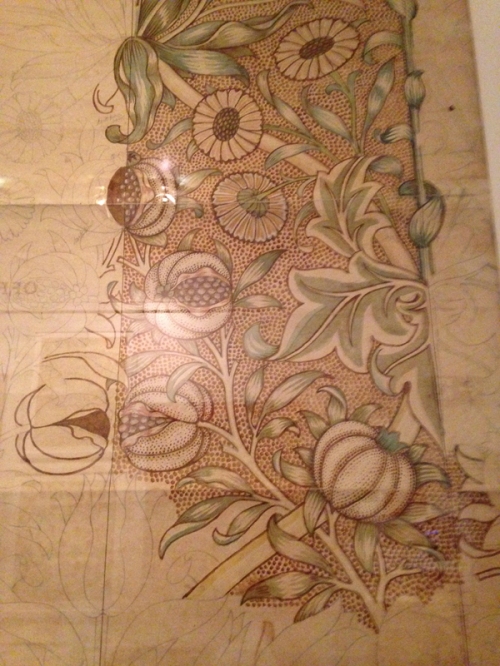For the last two weeks, my husband and I have been prepping the house for a floor refinishing: a crew will come in on Monday and begin to bring the tired red-oak hardwood floors back to their former glory. Clearing the books, furniture and tchotchkes out (oh, my God, so many books, so many tchotchkes) has helped me organize a few things, it’s true. But the empty main floor rooms now echo when we speak, and the effect is strange. It’s eerie, emptying out a house without actually moving out – a little like having a family member suddenly go berzerk and start running around naked. I feel both amused by it and embarrassed for it…
[…funny how typing out the word “embarrassed” makes me see how similar it is to “bare assed”….]
Sorry – what was I saying? It’s easy to fall right off a cliff when it comes to thinking about how strange words are, isn’t it? Ah, yes, I was talking about an empty house.
When a house gets down to only walls, floors, ceilings and windows, all the flaws of the poor creature show. The little buckles in the wallboard underneath the bedroom windowsills where condensation dripped before we could afford to replace the old windows – we’ve been meaning to fix those for so long. Then there’s the dust on the very top of the tall dining room hutch – you know, where I haven’t dusted since we moved it in twenty-eight years ago. There’s the newly exposed place behind the bookcases that’s a different color than the rest of the room – we got lazy and didn’t move the bookcases when we repainted. Time to unlaze.
On and on it goes, the list of little neglected things about an old house – bedraggled, rumpled, familiar. Both sweet and destitute. It’s as if our house over the years became an old hooker with a heart of gold. Or a featured structure on the Abandoned NYC blog.
This is the point in my post where I might normally turn the whole “empty house” thing into a metaphor for the writing process, but honestly, the hard work of emptying each room has left me feeling singularly uncreative, mentally. Hard work can do that – which is obvious if you think about how few coal miners or restaurant dish-washers or factory-line workers have enough energy left to be creative. And this hard labor moment of mine is temporary – I’m not going down any mine shafts day after day.
For example, I took time out for the Oscars (even the red-carpet silliness.) And I took a walk around Greenlake because February sunshine in Seattle cannot be ignored. And even with all I’ve had to do, I’ve been conscientiously reading the headlines from all the newsletters and posts I get in my email each morning via the New Yorker, The New York Times, Bill Moyers, Facebook, The Guardian, ad infinitum. When I’m tired, I save up the reading of the whole articles/essays for “later.”
I’m going to share half-a-dozen links from my last list of Things-to-Read-Later, which I’ve just managed to go back and read now that the rooms echo. Each bit and piece has something to do with creative endeavors, which is what Books Around the Table is all about, and which I hope to get back to more fully once the rooms of the house are full again, and which (in a perfect world) everyone would have the time and energy for.
You can follow these links at your own convenience, depending on the state of your house, state of your head, state of your free time, and/or your comfort level with disorganized browsing. My comfort level with that activity lately has been high.
1. Click here for a gorgeous piece of writing by George Szirtes for the latest issue of Poetry: “Formal Wear: Notes on Rhyme, Meter, Stanza and Pattern.” It’s an essay for those of us interested in poetry’s musicality and mystery. Here’s a teaser: “Sure, rhyme can be predictable. The good poet’s job is to make it less so. On the other hand rhyme is also a mnemonic and an early pleasure. Rhyme is an extraordinary and surprising coincidence….I would contend that the constraints of form are spurs to the imagination: that they are in fact the chief producers of imagination.”
2. Click here and here to see the paper-sculpture work of Patti Grazini, who has a new show currently at Seattle’s Curtis Steiner Gallery. Grazini never fails to amaze.
3. Click here for some thoughts of my own over at Write At Your Own Risk, about what to keep, what to throw out, what you own, what owns you, how random news clippings can become sources of inspiration, and how basements come in handy.
4. Click here for a look at a N.Y. Times article about the National Gallery of Art’s new Robert Frank online archive. One of the photos in Frank’s book The Americans provided the inspiration for my first published poem. That article, by the way, is part of a wonderful series at the New York Times called LENS: Photography, Video and Visual Journalism. Articles from it often end up on my Read-It-Later list. Click here to see the most current posts.
5. Click here to read an interview in which the director Alejandro Gonzalez Inarritu (who made Birdman) talks about reading Raymond Carver and Tolstoy.
6. I’ll share one of my poems with you because it’s about seizing the day and about Time with a capital T, as in never having enough.
Carpe Something
Before we can sneeze,
it’s another day.
In some accelerated way
it’s now impossible to seize
the day. Instead, let’s seize
things sideways, let’s side-step days,
let’s seize things month-wise.
Let’s give that a try, please.
Or thirty tries. Or thirty-one tries.
And that’s it for my post today. Bits and pieces this time around, while my muscles ache and my creativity recovers.













































